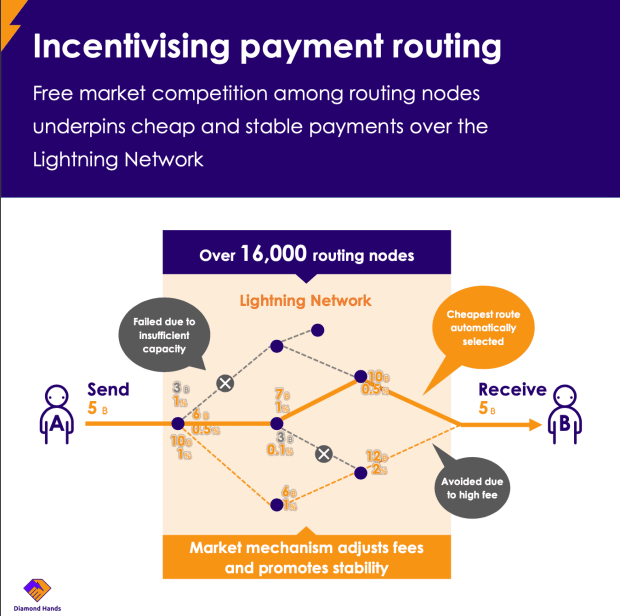Bitcoin’s Lightning Network is a Layer 2 technology that offers many advantages over altcoins for making Bitcoin into a peer-to-peer payments technology.
This is an opinion editorial by Yuya Ogawa, a software engineer and co-host of the Diamond Hands community.
This article is based on the content of the “Understanding Lightning” report produced by the Diamond Hands community, the largest Lightning Network community in Japan. The report aims to provide an overview of Lightning’s technology and ecosystem for a non-technical audience.
What’s So Special About The Lightning Network?
Bitcoin was brought into this world over a decade ago to enable peer-to-peer payments without the need for a trusted third party. In order to maintain this censorship resistance, Bitcoin limits its throughput to 1M vBytes per block, every 10 minutes, keeping it easy for anyone to run their own node.
The Lightning Network is Layer 2 technology built atop the Bitcoin blockchain, enabling faster and cheaper payments, massively improved scalability and better privacy without compromises to censorship resistance and decentralization. In this article, we relegate the technological specifics for another day, instead focusing on Lightning’s censorship resistance and scalability characteristics.

Decentralized And Censorship Resistant
Just like Bitcoin, Lightning users can run their own nodes and manage their own payment channels. This is in stark contrast to the vast majority of emerging Layer 2 technologies in the broader crypto ecosystem.
For example, rollups on Ethereum exist on-chain as a single on-chain smart contract that stores the state of all of its users — as opposed to thousands of distinct payment channels in Lightning’s case. For Ethereum, an operator node is in charge of managing and updating this state, therefore introducing a vector for censorship or exploitation. Even if Ethereum and Solana were sufficiently decentralized and censorship-resistant networks, Layer 2 users can be affected if the smart contract or operator node is censored or exploited.
In Lightning, each user creates payment channels to create a massive web for payments. Thus, even if a user is censored or exploited, the rest of the network remains functional. Although there is valid concern regarding the emergence of major hubs (popular nodes that attract many payment channels) and their vulnerability to censorship, even in such a case, users are free to create alternative payment channels to circumvent these nodes, if needed. This censorship-resistant dynamic, enabled by Lightning’s decentralization, is unparalleled by most other Layer 2 technologies.
Massively Scalable
Payments on Lightning usually traverse multiple payment channels to reach their destination. Typically, we see payments that are routed over no more than four or five hops (routing nodes). Assuming each hop takes one second, the payment is completed in four to five seconds. If the payment requires zero hops, i.e., if you share a payment channel with the destination, it will likely settle in a fraction of a second.
Fees are typically around 0.1% of the payment amount, so a $1 payment is likely to cost 0.1 cents in fees. For zero-hop payments, there is no fee. The throughput of each node is limited, with Lightning Network Daemon (LND) benchmark results suggesting that a node can process 50 transactions per second (tps) out-of-the-box (see details here). However, as mentioned in the report, software optimizations should be able to bring this figure to 1,000 tps. Moreover, since the network can process payments in parallel, if 1,000 pairs of nodes across the network all function at 1,000 tps, the network as a whole does 1,000,000 tps.

Routing Nodes, At Your Service!
Just as miners are incentivized by transaction fees and newly minted coins in proof-of-work mining, the nodes that forward payments across Lightning are incentivized by routing fees. A competitive market for hashing provides security to the Bitcoin blockchain; a competitive market for payment routing results in cheaper and more reliable payments on Lightning.
Since routing nodes earn a fee each time they forward a payment, they naturally aim to route as much value as possible. However, mispricing liquidity can lead to unbalanced channel capacity and routing failures — which benefit no one, including the routing nodes involved. In order to maximize their revenue, routing nodes attempt to balance their channels, improving payment success rates and settlement times across the network. More routing nodes also means more possible routes which can be used as alternatives, improving network reliability.

Summary
The Lightning Network is highly decentralized and censorship resistant thanks to its reliance on the Bitcoin blockchain where users can freely create new payment channels. Furthermore, similarly to how a competitive market for mining results in security on Layer 1, routing nodes compete with each other to provide stable and competitively priced payment forwarding on Lightning. Bitcoin enables trustless payments as envisioned by Satoshi Nakamoto over 10 years ago, and the Lightning Network is an attempt to vastly improve its scalability without compromising on those foundational values.
This is a guest post by Yuya Ogawa. Opinions expressed are entirely their own and do not necessarily reflect those of BTC Inc. or Bitcoin Magazine.
source https://bitcoinmagazine.com/technical/lightning-network-payment-technology-advantages

Post a Comment